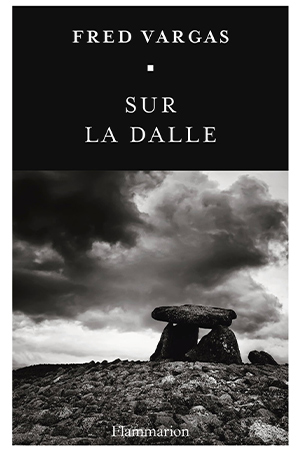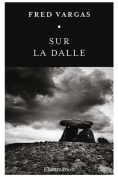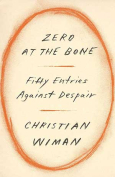Sur la dalle by Fred Vargas
 Paris. Flammarion. 2023. 512 pages.
Paris. Flammarion. 2023. 512 pages.
Although she had initially pursued a scientific career (in zooarchaeology), Frédérique Audoin-Rouzeau started writing detective novels in the 1980s under the pen name of Fred Vargas. Most of them feature the remarkably quirky commissaire (police captain) Jean-Baptiste Adamsberg, who leads an equally implausible team of investigators in Paris. Often lauded by critics, Vargas’s novels have consistently been bestsellers in France. Some of them have also been adapted to film. In the process, Adamsberg, the soft-spoken character with tortuous thought patterns, has become the best-known fictional detective in France since Georges Simenon’s Inspector Maigret. Vargas’s latest novel was published after a six-year hiatus, during which she wrote impassioned essays on the dangers of climate change.
Vargas regularly incorporates scientific and historical topics into Adamsberg’s investigations. In this case, it is literary history that provides a background and setting. Several grisly murders are carried out in Louviec, a fictional small town in the region of Bretagne, near the real castle of Combourg. In the late eighteenth century, the “illustrious inhabitant of this fortress” was François-René de Chateaubriand (1768–1848), one of the main forerunners of literary romanticism, which would flourish in France during the first half of the nineteenth century. As an added link to literary history, Vargas introduces into her narrative a fictional descendant of Chateaubriand, who conveniently happens to resemble portraits of the famous writer. It is to this small-town environment, steeped in a renowned literary past, that Adamsberg and part of his Parisian team are sent on an exceptional basis.
Historical references go much further back with the dalle (slab) of the title, which denotes the capstone or “table” of a dolmen, a megalithic tomb of the Late Neolithic period (4,000–3,000 bce) that is situated near the town where the murders take place. In the middle of his investigation, and even though he has been wounded and remains the target of a criminal gang, the unpredictable Commissaire Adamsberg decides to lie flat on top of the dolmen in order to sort out his various “thought bubbles.” While many of Adamsberg’s colleagues find him unbearably eccentric, they cannot deny that he has a long history of solving difficult cases, in spite of the fact that he regularly strays from the principles of Cartesian logic that should normally govern police procedures.
Adamsberg’s undisciplined but ultimately effective methods, combined with elaborate murder mysteries and detailed historical references, make up the appeal of Vargas’s police thrillers, most of which have been translated into English. Readers should be forewarned: the Adamsberg series, in particular, is habit-forming. It is therefore advisable to begin with the first novel of that series, The Chalk Circle Man, which was originally published in 1991.
Edward Ousselin
Western Washington University





























